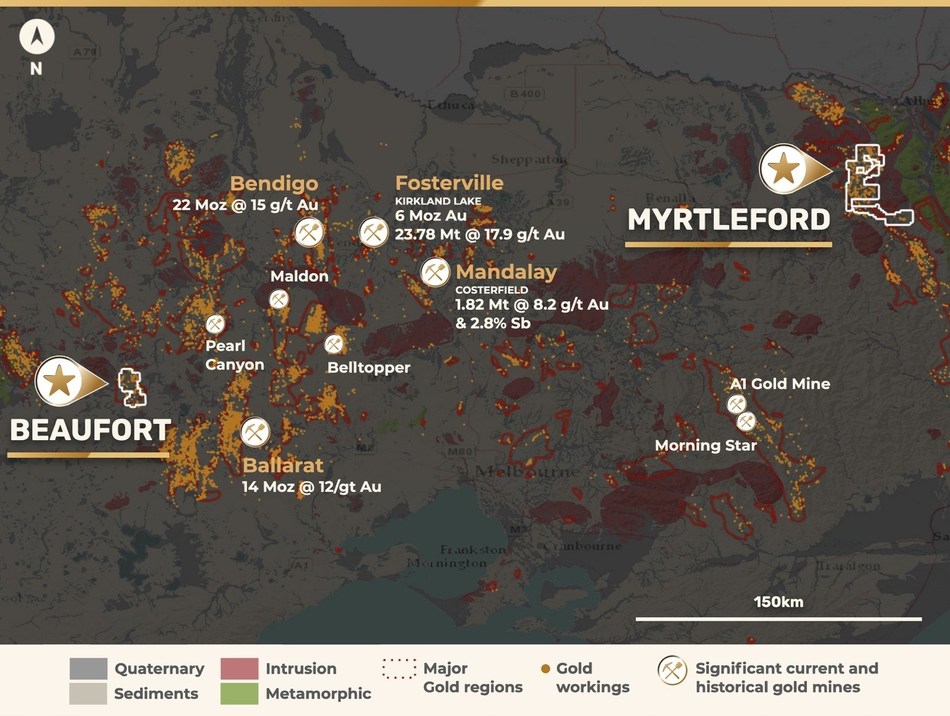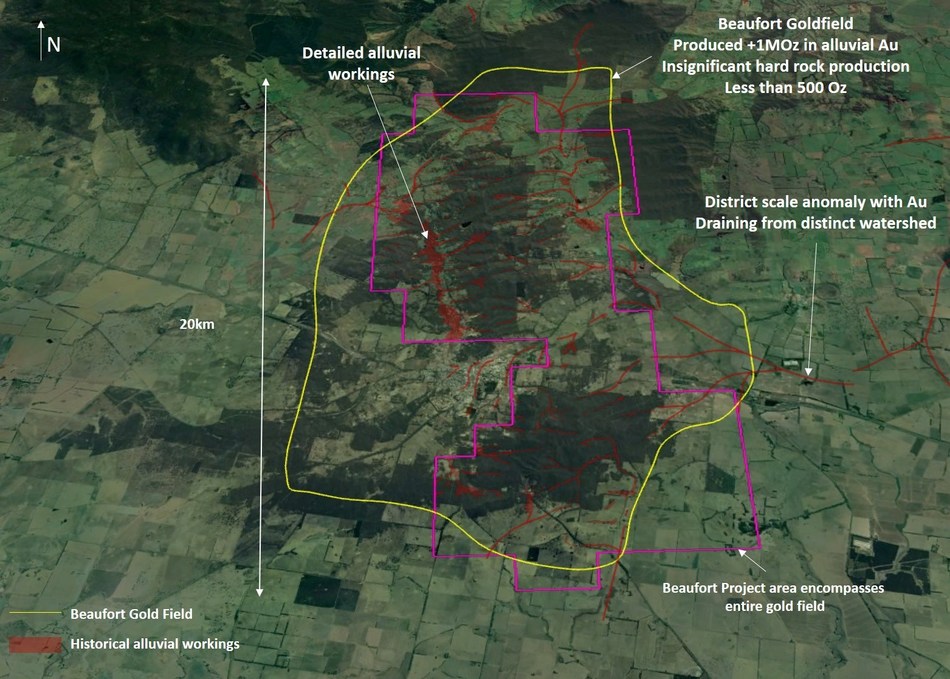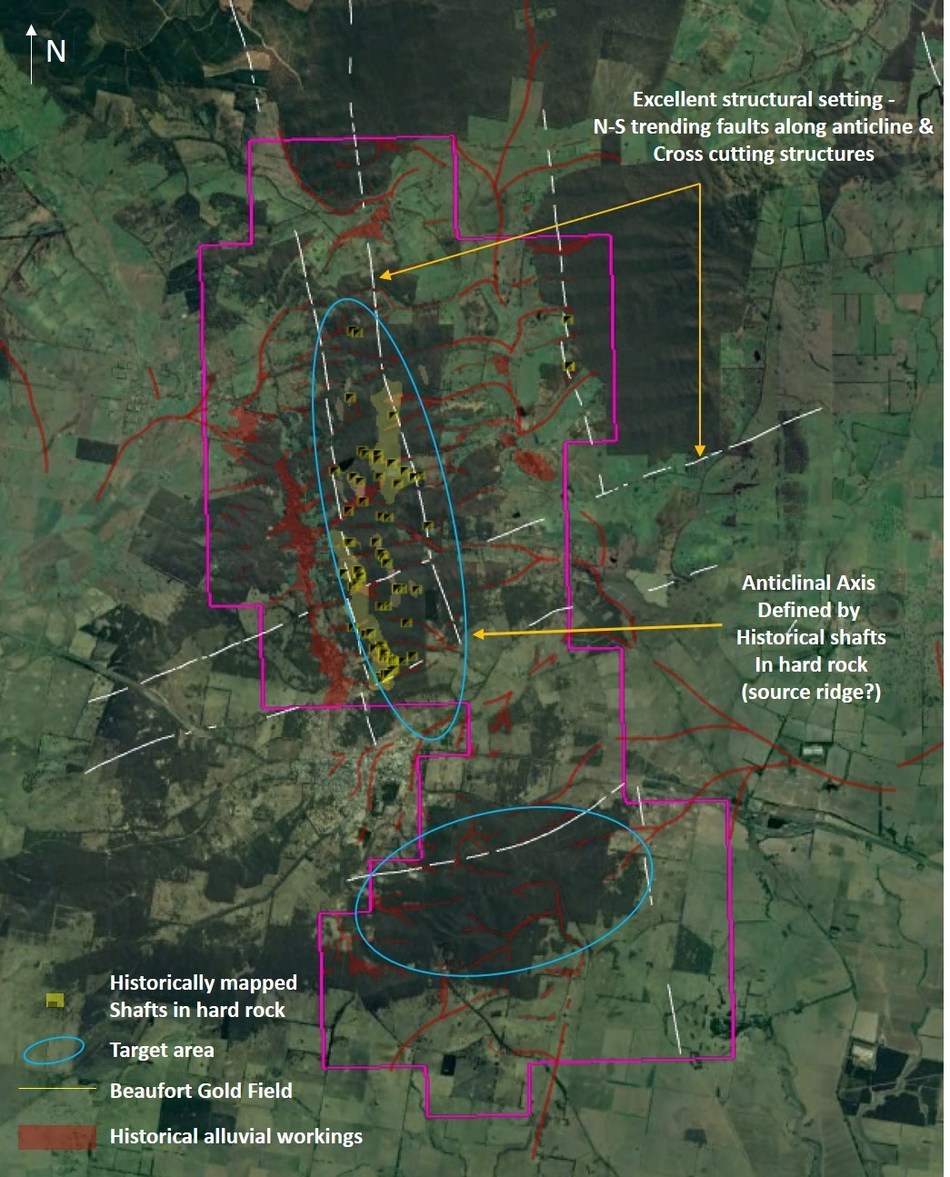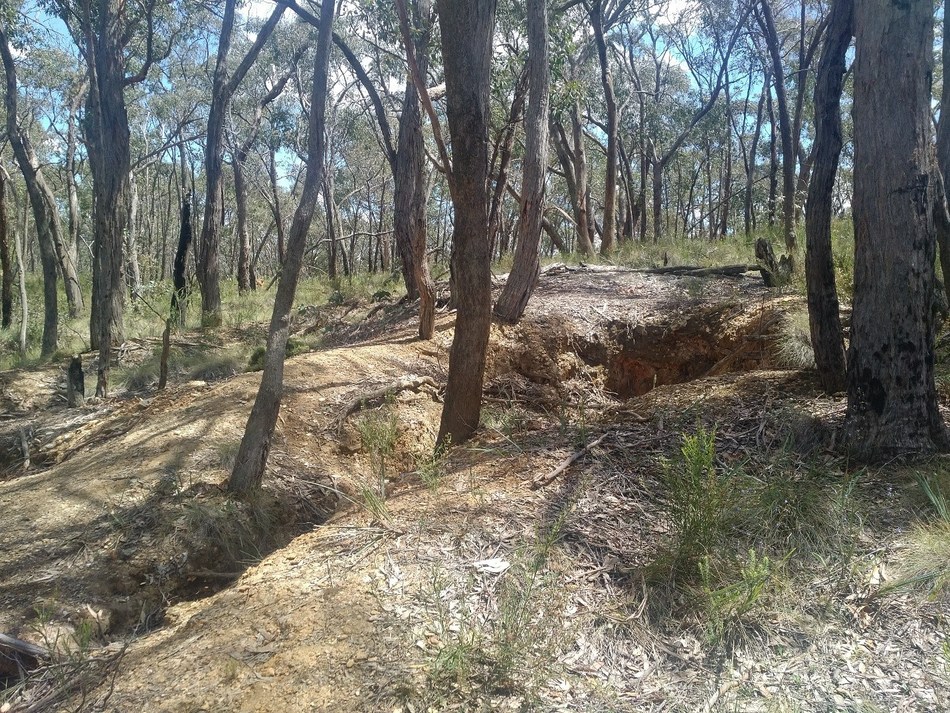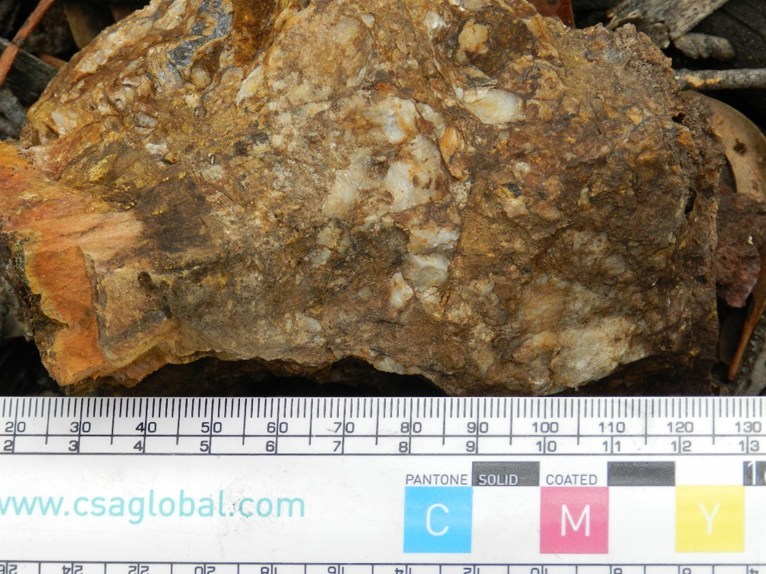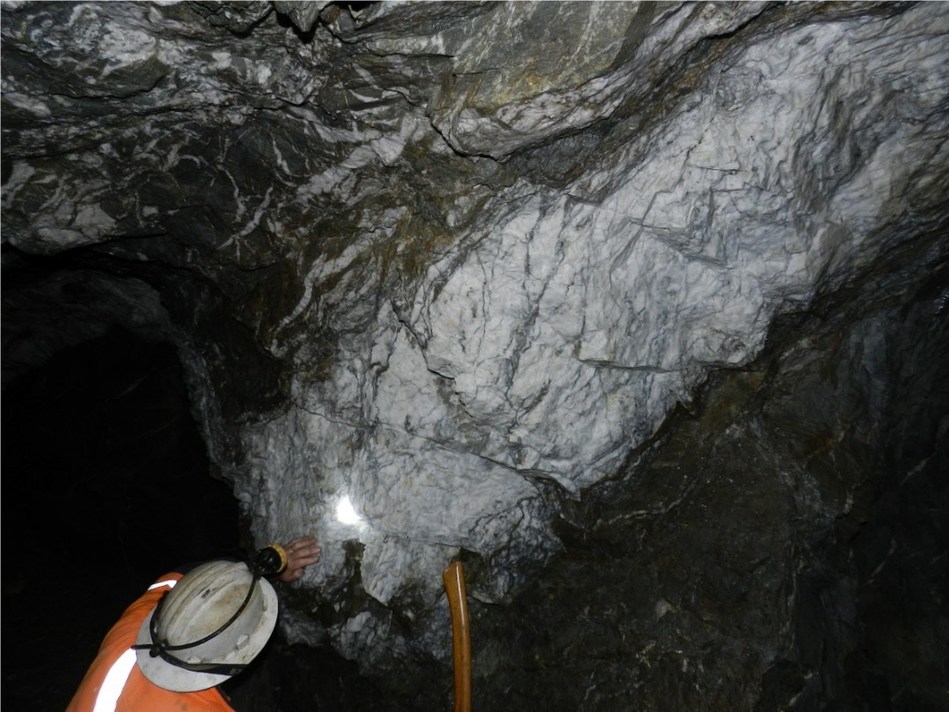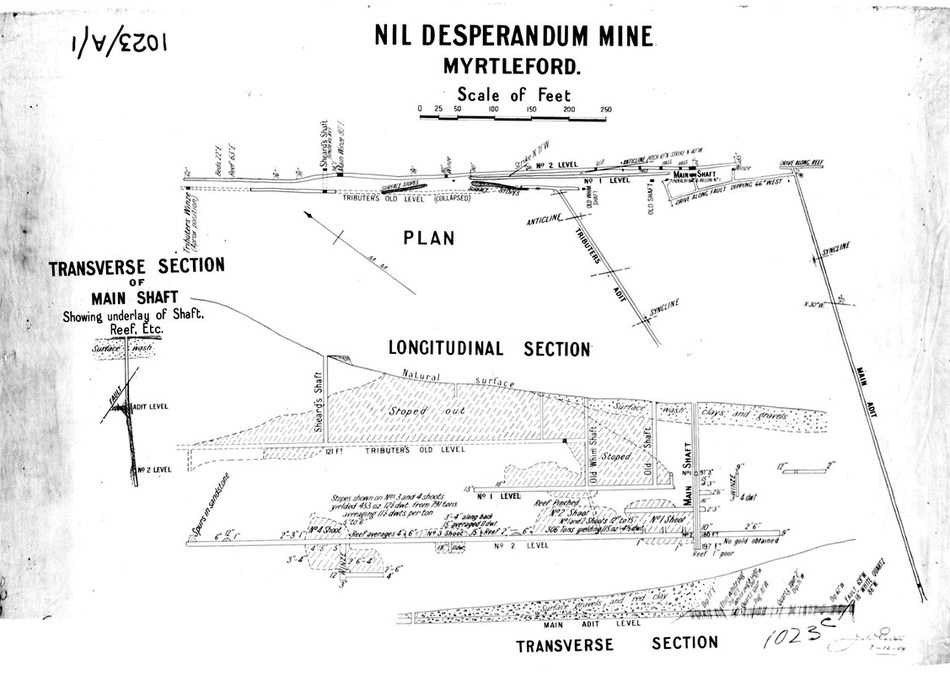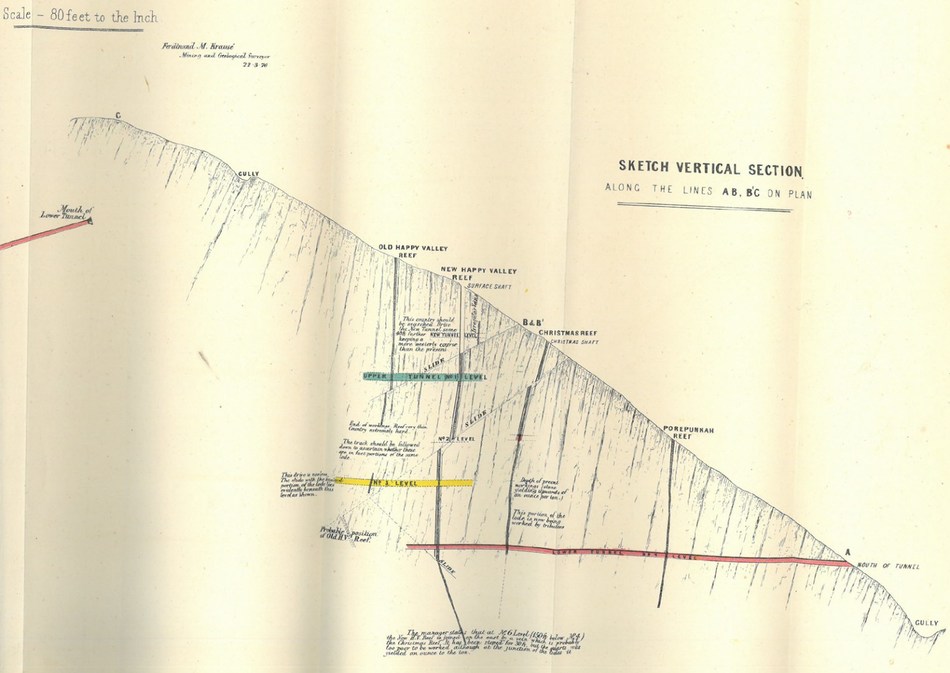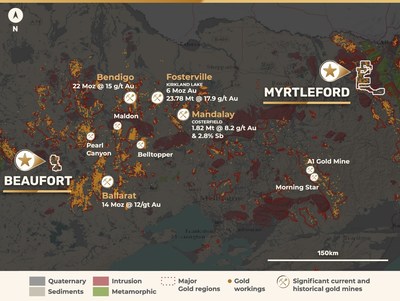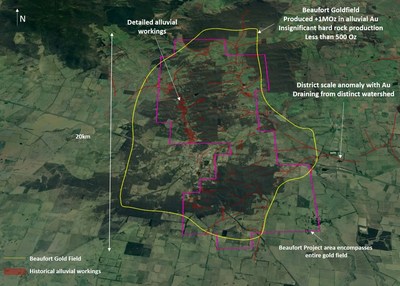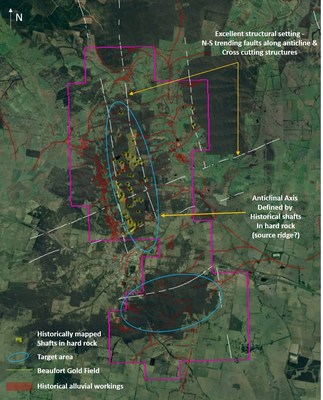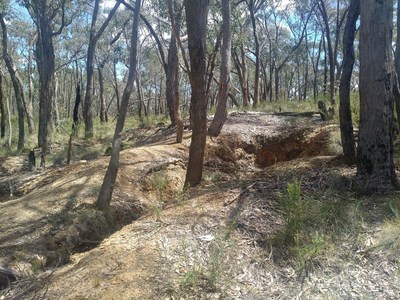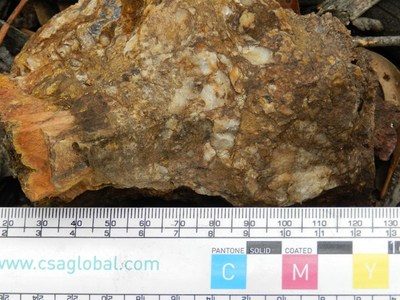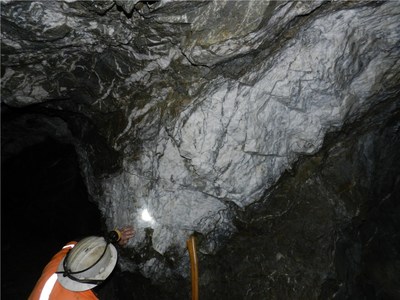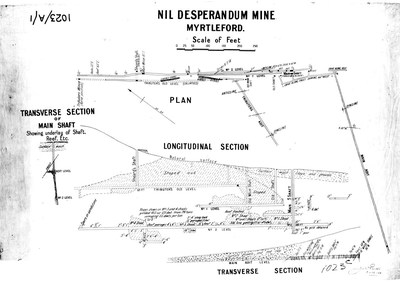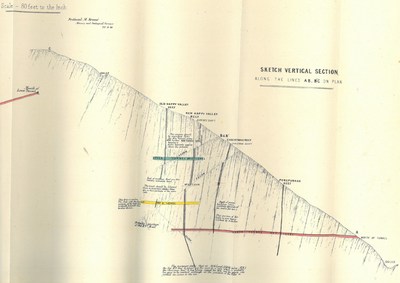E79 Resources Enters Agreement to Acquire Beaufort and Myrtleford Gold Projects in the Victorian Gold Fields, Australia
Canada NewsWire
VANCOUVER, BC, Oct. 26, 2020 /CNW/ – E79 Resources Corp. (CSE: ESNR) (“E79” or the “Company“) is pleased to announce it has entered into a deed of purchase agreement with E79 Resources Pty Ltd., a private Australian registered company (the “Australian Company”) and its shareholders (the “Purchase Agreement”), whereby it will acquire a 100% interest in two gold projects by acquiring all of the outstanding shares of E79 Resources Pty Ltd. The Beaufort and Myrtleford projects are located in the prolific and underexplored Victorian gold fields. The Beaufort project (120km2) and the Myrtleford project (418km2), are both situated within the same geological province and in a similar setting to the Fosterville gold deposit, which has evolved into a high-grade and considerably low-cost producing gold mine.1
The Beaufort project is hosted in a similar structural setting to Fosterville, is associated with a similar geochemical signature of elevated gold, arsenic and antimony along a structural trend and is hosted within similar Paleozoic sediments and proximal to the transition between Early and Late Devonian intrusions. The Myrtleford project hosts dozens of historical high-grade gold mines which the Company believes present multiple near-term drill targets.
“We are extremely pleased to announce the acquisition of two high-quality gold projects in one of the most sought after and competitive gold jurisdictions in the world, where over 80 million ounces of gold have been produced to date and where recent exploration has resulted in one of the most spectacular gold deposits in the world”, said Rory Quinn, E79’s President and Chief Executive Officer.
“At Beaufort, orientation soil sampling has defined a 2.5km long gold-arsenic-antimony trend, a common pathfinder geochemical association in the Victoria goldfields. It has seen an estimated 1.16 million ounces of historical alluvial gold production, including gold nuggets of up to 400 ounces, with no hard rock source yet identified. Beaufort has the potential for Fosterville-type mineralization. At Myrtleford, there are over 70 historical gold mines on the property with grades often greater than 1 ounce per tonne gold. Host rocks are of a similar age and type as those of the Bendigo Zone in central Victoria that host the Bendigo, Ballarat and Fosterville gold deposits.”
Highlights – Beaufort project
- Beaufort goldfield historically produced a significant amount of alluvial gold (estimates of up to 1.16Moz Au 2). It is considered an ‘enigmatic placer’, due to significant alluvial production with no obvious hard rock source
- Alluvial deposits are spatially associated with a north trending ridge which host numerous historical small-scale hard rock workings and pits
- The Geological Survey of Victoria has mapped a major structure and fold closure along the ridge line, which is analogous to numerous Victorian gold deposits
- Limited historical drilling is too shallow and too widely spaced for effective target definition of a Fosterville type target. However, drilling did define anomalous gold trends which remain untested at depth
- Gold nuggets of up to 400 oz 2 have been recovered from the historical alluvial mining operations – further supporting the presence of a proximal primary gold source
- Orientation soil sampling by the Australian Company has defined a 2.5km long gold-arsenic-antimony trend which is a common pathfinder geochemical association over gold deposits in Victoria
- Beaufort hosts large, high value targets, which remain untested and may present the potential for substantial discovery
Highlights – Myrtleford Project
- Interpreted to have contributed a large amount of gold to the adjacent Beechworth-Eldorado alluvial goldfield (estimates range up to 4Moz 3), and to have produced over 100koz Au 3 from high grade hard rock underground mines within the district
- The project encapsulates a significant portion of the historical production centre
- The structures within the permit host over seventy past producing high grade underground mines with average grades often greater than 1 oz/t gold 3
- Most historical mining operations terminated at shallow depths – generally at the water table due to limited pumping capacity at the time
- The large land package hosts anticipated extensive trends of mineralised structures which have not been systematically explored
- Myrtleford presents a rare opportunity, capturing the bulk of a significant gold district with proven high-grade hard rock mineralisation and extensive historical alluvial workings derived from these hard rock sources
- The Company will aim to define a series of high value targets for drill testing over the coming months
Victorian Gold Fields
Beaufort Project:
Exploration License (EL) “EL006454 Beaufort” is a granted exploration tenement located in the southwest of Victoria approximately 145km west of Melbourne, the capital of the State of Victoria. It is approximately 48km west of the regional town and historic gold mining centre of Ballarat (Pop. 105,471 in 2018).
The Beaufort Goldfield has been extensively mined in the past almost exclusively for alluvial gold, with an estimated 1.16 Moz 2 of historical production. Local primary sources for the alluvial gold have not yet been identified as historical production from bedrock mines was limited, an unusual and enigmatic situation in central Victoria.
Exploration tenements over the Beaufort goldfield have been held almost continuously since the 1960s. However, despite the attractiveness of the target area, exploration work for bedrock sources of gold has consisted of limited and unsystematic soil sampling, rock sampling, mapping, limited ground magnetics and shallow drilling (mostly up to 20 metre depths), with only a few reverse circulation holes penetrating the oxide zone.
This represents a unique opportunity for the Company to systematically evaluate and drill test the target area and associated anomalies which management believe is the source of the alluvial production.
Historical workings and previous exploration work on the Beaufort project area have established that gold mineralisation at surface is generally associated with ferruginised, brecciated and sheared quartz vein margins, with elevated gold values in a dark, pyritic slate trending northwest along the western limb of the regional anticlinal fold structure.
The conceptual model for the Beaufort goldfield is one in which gold may have been enriched in carbonaceous sedimentary rocks of the Beaufort Formation at, or shortly after their deposition. Potential concentration of this syngenetic gold occurred during regional metamorphism and deformation that formed the regional fold centred on the Camp Hill Range. Gold eroded from re-activated quartz veins subsequently accumulated in alluvial deposits during prolonged weathering and erosion.
Oxidation of disseminated sulphides associated with the structures and the quartz vein creates acidic groundwaters that would have likely leached gold from the oxide zone, and potentially reprecipitated this in the drainage systems. Early miners traced the origin of the gold to the dividing range as shown by extensive shallow workings and pits which lead up to the centrally located ridge. The leached saprolite near surface and potentially disseminated sulphide style of mineralisation were likely not viable targets for the small-scale miners but provide attractive targets for modern exploration.
Some of the highest gold grades from historical sampling (4 to 9 grams per tonne gold 2) are associated with quartz breccias and pyritic black shales near the hinge of the fold and will be the focus of further exploration work by the Company.
The dark pyritic slates have not been sampled below the oxide zone by previous explorers, nor have reactivated late, east-west tending structures been systematically targeted.
The Company is planning to implement an aggressive exploration program involving detailed and systematic soil sampling and mapping over the central ridge target zone. The objective will be to define extensions of the soil anomalies defined to date and drill test them as practical.
Myrtleford Project
Exploration License “EL006724 Myrtleford” is a granted exploration license and located in the north-east of Victoria, approximately 290 km northeast of the Victorian capital Melbourne and approximately 40 km south of the Victoria – New South Wales border cities of Albury – Wodonga. The license consists of a single contiguous parcel covering 418Km2 and was granted for an initial period of five years on July 3rd, 2020. The license is pending transfer to the Australian Company and the Purchase Agreement commits the shareholders of the Australian Company who presently hold the license to transfer it to the Australian Company, as soon as they are able to under applicable laws.
The Exploration License lies within a northwest-trending belt of alluvial and hard rock gold mines that collectively produced 6.3 Moz 3 in the past, mostly from alluvial mining, but also from hard rock production.
The northwest corner of the license overlaps the Beechworth-Eldorado goldfield which produced nearly 4 Moz 3 of this total historical production, which was primarily derived from alluvial deposits interpreted to be sourced largely from within the License area.
The Licence encompasses multiple historically operated quartz vein gold mines, with the bulk of production occurring from the 1860’s until the early 1910’s. Most of the historical mines exploited the veins only to the top of the water table, as the capital required to dewater was generally not available. There is very limited modern deep exploration drilling, with the exception of two diamond drill holes completed in the south-eastern portion of the exploration licence at the Happy Valley – Havilah goldfield.
Hard-rock (quartz) mining generally commenced in the mid-1860’s as rich alluvial deposits were quickly depleted. Initial surface outcropping reefs were often extremely rich, in many cases averaging several ounces of gold per tonne. However due to the narrow nature of the quartz reefs, most operations were undertaken by individual parties or small syndicates. This resulted in a lack of capital and usually meant operations ceased when they reached the standing groundwater table. Only a few larger operations were developed within the licence area and of these only a small percentage were sunk to any depth.
This presents the Company with multiple, near term drill targets below the levels of the historical high-grade gold mines. The Company and its consultants are developing a work program to delineate drill targets in the near term.
Victorian Goldfields Background 2,3,4
The State of Victoria was one of the world’s leading sources of gold during the 1850’s. It has had only modest sustained exploration activity since. The opportunity exists today for a major find similar to those of the past, a unique opportunity in a tier one jurisdiction like this. It is likely that there are deposit types which were either unrecognized during the 19th century or were recognized but were uneconomic at the time. The nature of gold mining economics in the 19th century meant that gold grades of 15-30 g/t Au were necessary to achieve profitability.
The Company is presented with an opportunity to apply modern exploration techniques and technology in highly underexplored districts within a major gold province.
The Victorian Gold Province is located within the Western Province of the Paleozoic Lachlan Orogen. Gold deposits occur within complexly deformed Cambro-Ordovician to Silurian sedimentary rocks and, to a lesser extent, in Devonian dykes. The Victorian Gold Province is estimated to have produced around 80.4Moz of gold since the 1850s from a combination of alluvial, buried placer (deep leads), and hard rock quartz (reef) mines. The largest single goldfield at Bendigo is estimated to have produced at least 22.4Moz of gold, primarily from hard rock underground mines at an estimated average grade of over 10 g/t Au.
Qualified Person
Dennis Arne, MAIG (RPGeo), PGeo (British Columbia), a “Qualified Person” as defined by National Instrument 43-101, has read and approved all technical and scientific information contained in this news release. Dr. Arne is the owner of Telemark Geosciences Pty Ltd, a geological consulting services company based in Victoria, Australia.
Purchase Agreement
E79 has entered into the Purchase Agreement with the Australian Company and its shareholders to acquire all of the outstanding shares of the Australian Company. E79 will issue 20,000,000 shares to the shareholders of the Australian Company on a pro rata basis, of which 14,000,000 of such shares will be subject to contractually agreed restrictions on transfer. 2,000,000 shares will be restricted until February 8, 2021;
4,000,000 shares will be restricted until April 7, 2021; 4,000,000 shares will be restricted until July 7, 2021; and 4,000,000 shares will be restricted until October 7, 2021. Closing conditions include E79 completing its filing requirements with the CSE and the parties determining sufficient funding to carry out the desired exploration programs on the Beaufort and Myrtleford projects.
In connection with the Purchase Agreement and the Company’s evaluation of the projects, the Company has arranged for technical reports to be prepared on both projects. The Company is concurrently filing “NI 43-101 Technical Report EL006454 Beaufort, Southwest Region, Victoria, Australia” by Dennis Arne, MAIG (RPGeo), PGeo dated October 22, 2020 and “NI 43-101 Technical Report EL006724 Myrtleford Northeast Region, Victoria, Australia” by Peter de Vries, MAIG, MAusIMM dated October 22, 2020.
About E79 Resources
E79 Resources is a CSE listed gold exploration company which is focused on applying both the most advanced exploration technologies and the most recent geological theories to the two gold projects in Victoria, Australia pending acquisition under the Purchase Agreement. Management believes that the Beaufort and Myrtleford properties present the Company with the potential for Fosterville-type mineralization. The Company will also continue to evaluate corporate development opportunities in the underexplored and prolific Victorian gold fields.
Proposed Management and Board
E79 has called an annual general meeting of its shareholders for December 9, 2020 (the “Shareholder Meeting“) for usual AGM purposes, as required by corporate law. At that time, and as will be disclosed in the information circular to be prepared in connection with the Shareholder Meeting, the Company may consider additional nominees to the Board or other roles at the Company for the shareholders of the Australian Company.
Rory Quinn, President, Chief Executive Officer and proposed Director of E79
Mr. Quinn has over 15 years of capital markets experience in the global gold mining space and is the former Director, Investor Relations, at Wheaton Precious Metals (previously Silver Wheaton). During his tenure at Wheaton from 2012 to 2019, he worked on acquisitions totalling over US$6 billion as the company built its precious-metals business. Mr. Quinn has been involved in the review of hundreds of mining companies and mining assets from large precious-metal producers to earlier-stage developers and explorers in assessing high-quality investment opportunities around the globe.
Martin Pawlitschek, shareholder of the Australian Company and proposed Chief Geoscientist and Director of E79
Mr. Pawlitschek is an international mining professional with over 20 years experience, who has held key management positions with a number of junior explorers, private equity investment funds, majors (BHP) and development companies (MDL, Teranga). Cofounder of several resource companies in Eastern Europe and other successful exploration ventures in West Africa.
Grant Wechsel, representative of a shareholder of the Australian company and proposed Director of E79
Mr. Wechsel is the co-founder and executive director of Ortus Mining Capital and Mining Projects Accelerator (MPX). Grant is focused on developing and growing businesses, creating win/win outcomes with business partners, investors and clients. Grant drives the business development, marketing and capital raising functions of MPX and Ortus with a focus on delivering business growth and excellent returns for shareholders and investors.
Grant previously co-founded One Key Resources in 2010, a large mining services business which he grew to in excess of $250 Million in annual sales revenues. In 2016, a private equity backed, UK based firm acquired a majority of that business. During this time, Grant worked closely with some of the world’s largest mining companies on in excess of 90 different mine sites across Australia and maintains active business interests in the Australian mining industry today. Grant also enjoys numerous other roles as board director, advisory board member and/or investor in businesses across Australia, Singapore and Indonesia.
Dusko Ljubojevic, shareholder of the Australian Company and proposed Advisor to E79
Mr. Ljubojevic is an experienced resource industry executive and geologist with over 15 years of broad experience. Currently, Dusko serves as the CEO of ASX listed Raiden Resources and has served on the advisory board of a number of private companies; served as a consultant and an advisor to private equity funds and global development companies, including roles in a number of startup companies.
Simon Cohn, representative of a shareholder of the Australian company and proposed Advisor to E79
Mr. Cohn is a co-founder of Ortus Mining Capital, where he shared a vision to form a project generator in Australia that accelerated not only the exploration process but the focus on project development. After discovering the AI and machine learning capability of our technology partner Orefox, Simon worked closely with the remainder of the Ortus board in developing the MPX initiative.
Simon holds a number of advisory roles as Non-Executive Director, drawing on a wealth of leadership, professionalism, passion and knowledge built up over 19 years’ experience in the natural resources sector. A dynamic and astute mining executive, Simon was Managing Director at MEC Mining since 2011, and took on the role of Non-Executive Director in 2017. His extensive experience in the mining industry includes roles working across a wide range of open-cut and underground metalliferous and coal mines throughout Australia and overseas.
Simon is passionate about engaged, inspired leadership and in his Director roles he coaches and mentors senior leadership teams. He strongly believes in building a unified team whose members are empowered to act autonomously while sharing a common goal and prioritises robust partnerships with clients, other businesses and employees.
End Notes
1 Reference to nearby projects is for information only and there is no assurance that the Company will achieve similar results in respect of the E79 properties.
2 NI 43-101 Technical Report EL006454 Beaufort, Southwest Region, Victoria, Australia prepared for E79 and filed on SEDAR
3 NI 43-101 Technical Report EL006724 Myrtleford Northeast Region, Victoria, Australia prepared for E79 and filed on SEDAR
4 Source – ‘Victorian Gold Province, Australia‘ – GeoScience Victoria – 2010
Neither the Canadian Securities Exchange nor its Regulation Services Provider accepts responsibility for the adequacy or accuracy of this release.
Cautionary Note Regarding Forward-Looking Statements
This news release contains certain statements that may be deemed “forward-looking statements” with respect to the Company within the meaning of applicable securities laws. Forward-looking statements are statements that are not historical facts and are generally, but not always, identified by the words “expects”, “plans”, “anticipates”, “believes”, “intends”, “estimates”, “projects”, “potential”, “indicates”, “opportunity”, “possible” and similar expressions, or that events or conditions “will”, “would”, “may”, “could” or “should” occur. Although E79 believes the expectations expressed in such forward-looking statements are based on reasonable assumptions, such statements are not guarantees of future performance, are subject to risks and uncertainties, and actual results or realities may differ materially from those in the forward-looking statements. Such material risks and uncertainties include, but are not limited to, the Company’s ability to close on its purposed purchase of the Australian Company, raise sufficient capital to fund its obligations under its property agreements going forward, to maintain its mineral tenures and concessions in good standing, to explore and develop its projects, to repay its debt and for general working capital purposes; changes in economic conditions or financial markets; the inherent hazards associates with mineral exploration and mining operations, future prices of copper and other metals, changes in general economic conditions, accuracy of mineral resource and reserve estimates, the potential for new discoveries, the ability of the Company to obtain the necessary permits and consents required to explore, drill and develop the projects and if obtained, to obtain such permits and consents in a timely fashion relative to the Company’s plans and business objectives for the projects; the general ability of the Company to monetize its mineral resources; and changes in environmental and other laws or regulations that could have an impact on the Company’s operations, compliance with environmental laws and regulations, dependence on key management personnel and general competition in the mining industry. Forward-looking statements are based on the reasonable beliefs, estimates and opinions of the Company’s management on the date the statements are made. Except as required by law, the Company undertakes no obligation to update these forward-looking statements in the event that management’s beliefs, estimates or opinions, or other factors, should change.
SOURCE E79 Resources Corp.


